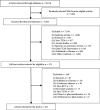The Use of Multiple Primary Outcomes in Randomized Controlled Trials of Chinese Herbal Medicine
- PMID: 33995551
- PMCID: PMC8081594
- DOI: 10.1155/2021/9975351
The Use of Multiple Primary Outcomes in Randomized Controlled Trials of Chinese Herbal Medicine
Abstract
Background: Multiple primary outcomes are commonly used in randomized controlled trials (RCTs) of Chinese herbal medicine (CHM). Analysis and interpretation of the results of CHM RCTs with many outcomes are not clear. No previous studies have systematically assessed the use of multiple primary outcomes in this area. This study aimed to assess the reporting of multiple primary outcomes and the statistical methods used to adjust multiplicity in RCTs of CHM.
Methods: Search for RCTs of CHM published in English between January 2010 and December 2019 in MEDLINE, EMBASE, and the Cochrane Central Register of Controlled Trials (CENTRAL) was undertaken. We randomly selected 20% of the included RCTs as the analyzing sample of this study. The number of multiple primary outcomes, the methods used to adjust the multiplicity in statistical analysis and sample size estimate, and the trial information were collected. For RCTs that adopted multiple primary outcomes without the multiplicity adjustment, we used Bonferroni correction to adjust.
Results: 227 CHM RCTs were included in our study. 92 (40.5%) failed to report what their primary outcome was. Of 135 (59.5%) RCTs that reported primary outcome, 93 (68.9%) reported one and 42 (31.1%) reported more than one primary outcome (range 2-5). Of 42 RCTs that reported multiple primary outcomes, only 5 adjusted for multiple outcomes. If multiplicity had been accounted for using Bonferroni correction, 10 (37.0%) RCTs that reported a significant result had demonstrated a nonsignificant result, giving the adjusted P value. Only one of the 42 RCTs calculated sample size based on multiple primary outcomes. Adopting multiple primary outcomes showed a slow growth trend with the publication year. The proportion of primary outcome reported explicitly in RCTs was different in terms of the nationality of the first author (P=0.004), in which mainland China has the lowest proportion (55.8%). The highest percentage of the studies with primary outcome reporting explicitation was mental and behavioural disorders (83.3%), and the most frequently adopting multiple primary outcomes were studies on the disease of the nervous system (66.7%). The percentage of reporting primary outcome explicitly was associated with sample size (P < 0.001); for the percentage of RCTs adopting multiple primary outcomes, there was no statistically significant difference (P=0.739).
Conclusions: Multiple primary outcomes are prevalent in CHM RCTs. However, appropriate methods are not usually taken in most of the analyses to safeguard the inferences against multiplicity. Sample size estimation based on multiple primary outcomes is still lacking. These issues complicate the interpretability of trial results and can lead to spurious conclusions. Guidelines to improve analyzing and reporting for multiple primary outcomes in CHM RCTs are warranted.
Copyright © 2021 Jing Hu et al.
Conflict of interest statement
The authors declare that there are no conflicts of interest regarding the publication of this article.
Figures
Similar articles
-
Randomized controlled trials of Chinese herbal medicine published in English from 2010 to 2019: a bibliometrics study.Ann Palliat Med. 2021 Dec;10(12):12945-12954. doi: 10.21037/apm-20-1033. Epub 2021 Feb 11. Ann Palliat Med. 2021. PMID: 33615810
-
Improving the quality of randomized controlled trials in Chinese herbal medicine, part III: quality control of Chinese herbal medicine used in randomized controlled trials.Zhong Xi Yi Jie He Xue Bao. 2006 May;4(3):225-32. doi: 10.3736/jcim20060302. Zhong Xi Yi Jie He Xue Bao. 2006. PMID: 16696906
-
Improving the quality of randomized controlled trials in Chinese herbal medicine, part I: clinical trial design and methodology.Zhong Xi Yi Jie He Xue Bao. 2006 Mar;4(2):120-9. doi: 10.3736/jcim20060204. Zhong Xi Yi Jie He Xue Bao. 2006. PMID: 16529686
-
Are multiple primary outcomes analysed appropriately in randomised controlled trials? A review.Contemp Clin Trials. 2015 Nov;45(Pt A):8-12. doi: 10.1016/j.cct.2015.07.016. Epub 2015 Jul 26. Contemp Clin Trials. 2015. PMID: 26215934 Review.
-
Chinese herbal medicine for epidermal growth factor receptor inhibitor-induced skin rash in patients with malignancy: An updated meta-analysis of 23 randomized controlled trials.Complement Ther Med. 2019 Dec;47:102167. doi: 10.1016/j.ctim.2019.08.001. Epub 2019 Sep 9. Complement Ther Med. 2019. PMID: 31780021
Cited by
-
The need for further guidance on the handling of multiple outcomes in randomized controlled trials: a scoping review of the methodological literature.J Clin Epidemiol. 2025 May;181:111724. doi: 10.1016/j.jclinepi.2025.111724. Epub 2025 Feb 17. J Clin Epidemiol. 2025. PMID: 39971166 Free PMC article.
References
-
- Chen K., Qian Z., Zhang W., et al. Analysis of the effect of refined Guanxin tablets on 112 patients with angina pectoris. Bulletin of Medical Research. 1982;11:24–25.
Publication types
LinkOut - more resources
Full Text Sources




